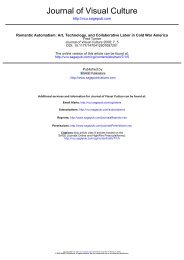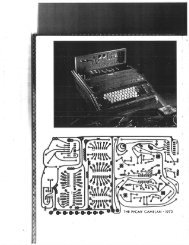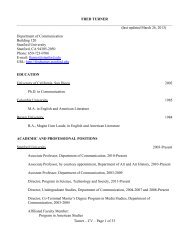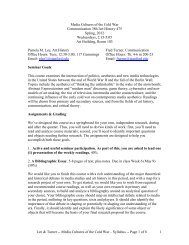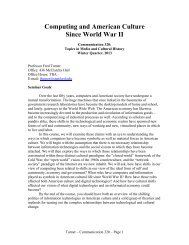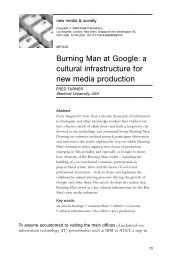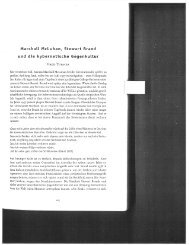The Family of Man and the Politics of Attention in ... - Public Culture
The Family of Man and the Politics of Attention in ... - Public Culture
The Family of Man and the Politics of Attention in ... - Public Culture
You also want an ePaper? Increase the reach of your titles
YUMPU automatically turns print PDFs into web optimized ePapers that Google loves.
<strong>Public</strong> <strong>Culture</strong><br />
hall, <strong>the</strong>y faced a wall with n<strong>in</strong>e close- up portraits <strong>of</strong> identical size <strong>and</strong>, set among<br />
<strong>the</strong>m, a mirror. Alongside <strong>the</strong>se pictures, Steichen placed <strong>the</strong> words <strong>of</strong> Russell:<br />
“<strong>The</strong> best authorities are unanimous <strong>in</strong> say<strong>in</strong>g <strong>the</strong> war with hydrogen bombs is<br />
quite likely to put an end to <strong>the</strong> human race. <strong>The</strong>re will be universal death —<br />
sudden only for a fortunate m<strong>in</strong>ority, but for <strong>the</strong> majority a slow torture <strong>of</strong> disease<br />
<strong>and</strong> dis<strong>in</strong>tegration.” <strong>The</strong> portraits <strong>in</strong> turn featured <strong>the</strong> suffer<strong>in</strong>g faces <strong>of</strong> three<br />
men, three women, <strong>and</strong> three children <strong>and</strong>, among <strong>the</strong>m, an American soldier,<br />
fresh from battle, almost certa<strong>in</strong>ly <strong>in</strong> Korea. At <strong>the</strong> center <strong>of</strong> <strong>the</strong>se pictures, <strong>the</strong><br />
viewer saw his or her own face. Steichen <strong>and</strong> Miller removed <strong>the</strong> mirror after<br />
two weeks, hav<strong>in</strong>g come to believe that it was “corny <strong>and</strong> wrong.” 37 But <strong>the</strong> hope<br />
beh<strong>in</strong>d it rema<strong>in</strong>ed. As Steichen put it, “When people come out <strong>of</strong> this show<br />
<strong>the</strong>y’ll feel that <strong>the</strong>y’ve looked <strong>in</strong> a mirror; that we’re all alike.” 38<br />
Even as <strong>the</strong>y saw <strong>the</strong>mselves <strong>in</strong> <strong>the</strong> mirror, viewers could glimpse beyond <strong>the</strong><br />
faces ano<strong>the</strong>r wall <strong>and</strong> a soldier, nationality unknown, facedown <strong>in</strong> <strong>the</strong> dirt, his<br />
rifle stuck <strong>in</strong> <strong>the</strong> ground to mark his body. When <strong>the</strong>y turned <strong>and</strong> walked past <strong>the</strong><br />
soldier, visitors entered a chamber <strong>and</strong> faced <strong>the</strong> one color image <strong>in</strong> <strong>the</strong> show: an<br />
eight- foot- tall transparency <strong>of</strong> a mushroom cloud. Until this po<strong>in</strong>t <strong>in</strong> <strong>the</strong> exhibition,<br />
visitors could me<strong>and</strong>er among an array <strong>of</strong> images; this picture <strong>of</strong> a hydrogen<br />
bomb explod<strong>in</strong>g was a choke po<strong>in</strong>t, a s<strong>in</strong>gle image that every viewer had<br />
to confront before mov<strong>in</strong>g on. For Steichen, <strong>the</strong> image clearly represented what<br />
might happen to <strong>the</strong> human race if <strong>in</strong>dividuals failed to recognize <strong>the</strong> qualities<br />
<strong>the</strong>y shared. In 1955 America, <strong>the</strong> image also likely rem<strong>in</strong>ded American viewers<br />
that it was <strong>the</strong>ir country as much as or more than any o<strong>the</strong>r that was driv<strong>in</strong>g <strong>the</strong><br />
atomic threat.<br />
Beyond <strong>the</strong> bomb, viewers cont<strong>in</strong>ued down a wide hallway <strong>and</strong> faced a series<br />
<strong>of</strong> portraits <strong>of</strong> male- <strong>and</strong>- female couples, each labeled “We two form a multitude.”<br />
<strong>The</strong>se images hung like street signs at a n<strong>in</strong>ety-degree angle from a wall- sized<br />
picture <strong>of</strong> <strong>the</strong> United Nations General Assembly. Just beyond <strong>the</strong> delegates, aga<strong>in</strong><br />
at a n<strong>in</strong>ety- degree angle, viewers could see <strong>the</strong> torso <strong>of</strong> a woman, draped <strong>in</strong> flowers,<br />
walk<strong>in</strong>g along <strong>the</strong> edge <strong>of</strong> <strong>the</strong> ocean. And beyond her, <strong>the</strong>y came <strong>in</strong> turn to a<br />
roomful <strong>of</strong> pictures <strong>of</strong> children play<strong>in</strong>g <strong>and</strong>, f<strong>in</strong>ally, to one <strong>of</strong> Life photographer<br />
W. Eugene Smith’s best- known images, <strong>The</strong> Walk to Paradise Garden. Just as<br />
<strong>the</strong>y were prepar<strong>in</strong>g to leave <strong>the</strong> exhibition hall, visitors saw Smith’s two toddler<br />
subjects, walk<strong>in</strong>g up out <strong>of</strong> a darkened, leafy bower. In <strong>the</strong> exhibition catalog, <strong>the</strong><br />
37. Wayne Miller, <strong>in</strong>terview by Mary Anne Staniszewski, July 18, 1996, quoted Staniszewski,<br />
Power <strong>of</strong> Display, 244.<br />
38. Edward Steichen, “ ‘<strong>The</strong> <strong>Family</strong> <strong>of</strong> <strong>Man</strong>,’ ” Vogue, February 1, 1955, 168, quoted Staniszewski,<br />
Power <strong>of</strong> Display, 244.<br />
80



